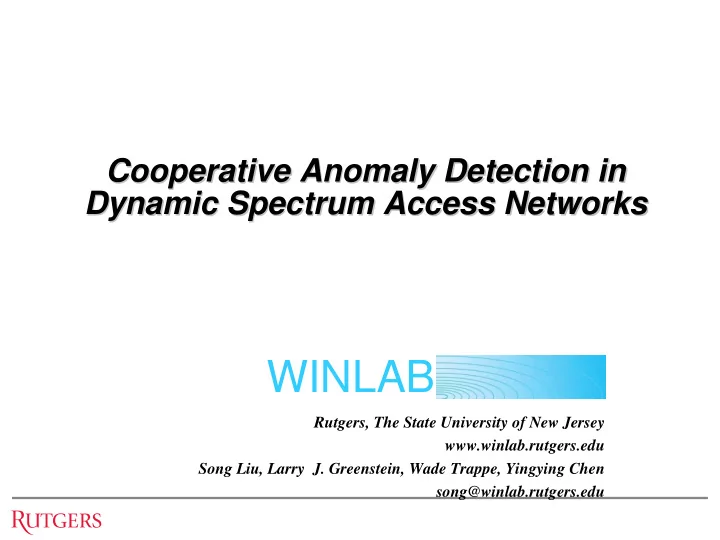

Cooperative Anomaly Detection in Cooperative Anomaly Detection in Dynamic Spectrum Access Networks Dynamic Spectrum Access Networks WINLAB Rutgers, The State University of New Jersey www.winlab.rutgers.edu Song Liu, Larry J. Greenstein, Wade Trappe, Yingying Chen song@winlab.rutgers.edu
Content Content � Background and Motivation � Network Structure with Spectrum Policy Enforcement � Anomaly Detection Using Significance Testing � Distributed Detection Using Energy Fingerprint � Summary and Ongoing Work WINLAB [2]
Motivation Motivation � Openness of the Lower-layer Protocol in Cognitive Radio (CR) – A flexible solution to dynamic spectrum access (DSA) – Target for adversaries and susceptible to reckless users � Spectrum etiquette enforcement is critical to effectiveness and correctness of a DSA system – Detection – Localization – Elimination WINLAB [3]
Detection of Anomalous Usage Detection of Anomalous Usage � Spectrum Anomaly: a spectrum usage that is not authorized by the DSA protocol and therefore can interfere with authorized (primary) users. � Distinguishing bad (unauthorized) transmissions from good (authorized) ones – Challenge : Conventional signal processing techniques are insufficient – Goal : Effective detection mechanism relying on non- programmable features WINLAB [4]
Radio Energy Based Fingerprint Detection Radio Energy Based Fingerprint Detection � Transmitters at different locations yield different “power maps” – Fingerprint : spatial distribution of the received signal strength – Its robustness has been shown in fingerprint localization [RADAR] -20 -20 -40 -40 RSSI RSSI -60 -60 -80 -80 20 20 15 15 10 10 5 5 20 20 15 Y 15 Y 10 10 5 0 5 0 0 0 X X Tx = (9, 10) Tx = (14, 8) WINLAB [5]
Sensor Assisted Anomaly Detection Sensor Assisted Anomaly Detection � Network Structure for Anomaly Detection – Primary (authorized) transmitter is stationary Distributed detection by a 3 rd -party sensor network – u sensors collaborate locally. WINLAB [6]
Energy Detection Model Energy Detection Model � FFT implementation of an energy detector � A lognormal approximation of the energy detector output – Assumption : signal bandwidth is sufficiently large so that M frequency samples are i.i.d. = Y 0,n + Y R,n , (dB) Y n – : path loss and shadow fading (correlated over space) Y 0,n – : multipath fading, independent (but may not be identical) over Y R,n space WINLAB [7]
Anomaly Detection Using Significance Testing Anomaly Detection Using Significance Testing � Statistics of the energy measurement only known under the normal condition: – s(t): authorized signal – x(t): unauthorized signal – unknown! – w(t): AWGN � Significance Testing – Test statistic T : a measure of observed data Acceptance Region Ω : we accept the null hypothesis if T ∈ Ω – Significance level α : probability of false alarm – WINLAB [8]
Distributed Anomaly Detection Distributed Anomaly Detection � Each sensor computes the residual error � The residues are exchanged among neighboring sensors � A differential fingerprint is constructed at each sensor � Based on the lognormal approximation, the residues are jointly normal distributed � An anomaly is declared if the difference is above a threshold – Acceptance region: – False alarm rate: WINLAB [9]
Simulation Evaluation Simulation Evaluation � A detection scenario – Path loss γ = 2 – Shadowing σ s = 6 dB – False alarm rate Q F = 0.05 – Transmission ISR = 0 dB – N = 100; R c = 0.25 R – 77 sensors have Q D > 0.9 ● : sensors with Q D > 0.9 ○ : sensors with Q D ≤ 0.9 � : sensors with <2 neighbors WINLAB [10]
Simulation Evaluation (2) Simulation Evaluation (2) � Percentage of sensors with a desired detection probability – ISR = -10 dB: > 70% of Pd > 0.99 for R c = 0.5R – ISR = 0 dB: > 93% of Pd > 0.99 for R c = 0.5R 100 100 d (%) d (%) 90 90 Percentage of receivers with desired P Percentage of receivers with desired P 80 80 70 70 60 60 50 50 P d > 0.9 P d > 0.9 P d > 0.95 P d > 0.95 40 40 P d > 0.99 P d > 0.99 30 30 0.2 0.3 0.4 0.5 0.6 0.7 0.8 0.9 1 0.2 0.3 0.4 0.5 0.6 0.7 0.8 0.9 1 Sensor communication range (R c ) Sensor communication range (R c ) ISR = 0 dB ISR = -10 dB WINLAB [11]
Summary and Ongoing Work Summary and Ongoing Work � We propose a cooperative detection method for anomaly detection in a dynamic spectrum access network – The method utilizes energy detectors so it is independent of the signal structure. � The detection is performed by exchanging energy measurements among locally distributed sensors and comparing the difference between two energy fingerprints � We formulate the detection problem as a significance test � Ongoing work – Empirical based threshold in an imperfect environment u Energy detector output is no long lognorm al at low SNR! u Em pirical detection threshold by a learning process – Decision fusion WINLAB [12]
WINLAB Questions? Questions? [13]
A Secure Method for Energy Calibration A Secure Method for Energy Calibration � Calibration signal: a PN sequence using On-Off-Key � A scheme analog to delayed key disclosure – The sequence is unknown to sensors during transmission – The exact sequence is announced a short time later via a public authentication channel between the authorized transmitter and sensors � Assumptions : – sensors can store and decode the sequence from the secret channel – Sensors are synchronous with the primary transmitter WINLAB [14]
A Secure Method for Energy Calibration A Secure Method for Energy Calibration � A maximum-length sequence (m-sequence) is sent twice – A sensor receives a cyclic shifted version of the m-sequence � Probability of accepting the calibration sequence (ISR=-10 & 0 dB) SNR = 0 dB SNR = 10 dB WINLAB [15]
Recommend
More recommend